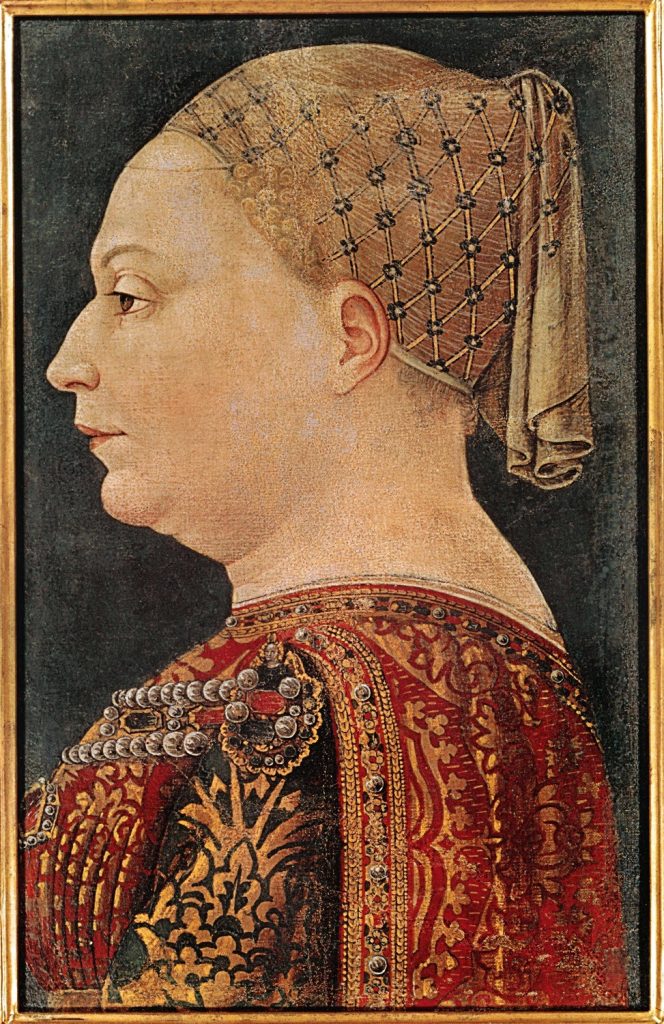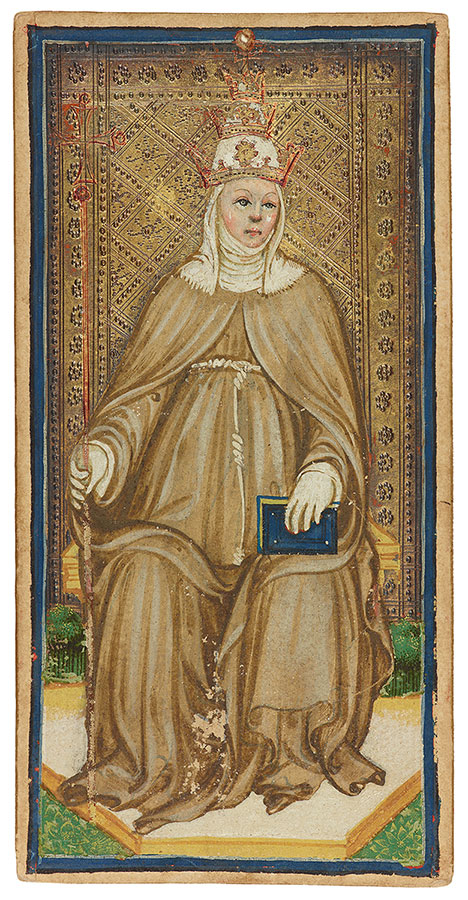In a remote mountain village above the town of Como, the confluence of two powerful women secured the fame of the “Popess.” This is Part 3 of a three-part post on Rainer Maria Rilke and The Popess tarot card. PART 1 | PART 2 | PART 3 | SOURCES | Brief Intro to the Tarot
Bianca Maria Visconti and Maddalena Albrizzi
Bianca Maria Visconti (1423–1468) was a direct descendant of Matteo Visconti, and the only child of Filippo Maria Visconti, duke of Milan. She and her husband, the successful condottiere (hired military commander) Francesco Sforza, ruled Milan and other towns in Lombardy, continuing the family’s accumulation of wealth and power.

Bianca likely learned of the saintly woman through her friends in Ferrara. Not only did the Visconti have strong ties with the d’Este family of Ferrara, her husband Francesco had been fostered and educated at the brilliant d’Este court.
Bianca’s interest in holy women was well-known. Still, in a milieu bustling with pious people performing helpful, domestic miracles—Guglielma was credited with curing headaches and encouraging the flow of breast milk—a long-dead holy woman might not have secured the duchess’s attention. Maifreda da Pirovano’s kinship to the Visconti, however, would have given her quite a shine. Having a saint in the family surely wouldn’t hurt the Visconti’s fortunes or reputation.
To get the process going, Bianca turned to her cherished spiritual mentor, Maddalena Albrizzi, abbess of a humble convent in Brunate. Bianca Maria frequently visited Maddalena at the remote convent and used her influence to further the abbess’s projects. Both women were particularly interested in the causes of women, ordinary and saintly.
Maddalena commissioned a fresco of Guglielma to be painted in the church of San Andrea, Brunate; Bianca paid for it. Still extant though heavily restored with overpainting, the fresco portrays Guglielma with two disciples, one of whom Newman identifies as Maifreda da Pirovano.
Bianca’s fascination with Maifreda extended even to her recreational pursuits: tarot cards.
The Popess of the Visconti-Sforza Tarot
The deck called the Visconti-Sforza Tarot was made circa 1450, the year Francesco Sforza and Bianca Maria Visconti became duke and duchess of Milan. It is one of the earliest extant tarot decks known. The heraldic devices that appear on the cards, as well as their lavishness and provenance, connect them to the ducal family. An archived letter by Francesco requests his secretary to procure “triumphi cards, the most beautiful that can be found.” We don’t know which deck in particular was procured in response to the letter, but the Visconti-Sforza tarot cards are very beautiful indeed.
The hand of Bonifacio Bembo, an artist who executed many artworks for the Visconti, can be seen in the childlike figures and flowing lines of the painted cards. Bonifacio painted in the International Gothic style, which developed between 1375 and 1425 as book illustrations, painted panels, and frescoes—and as the Visconti-Sforza cards. International Gothic bridges medieval Gothic, with its chunky figures and angular shapes, and the Renaissance, with its emphasis on naturalistic detail.

The cards were likely used mostly, if not exclusively, for gaming versus interpretation and fortune-telling, yet it is fitting that the images of the early tarot cards reflect the magical, iconic, even surreal qualities of medieval art, while venturing to themes that would resonate in Renaissance art: secular life, classical allegory, and philosophy that ventured beyond the bounds of Church commentary. Arthurian legend also figured in the artworks of the time. The Visconti-Sforza deck gives secular life its due especially in the court cards, which portray men and women clad in sumptuous garments, some trendy, some old-fashioned, some militant, befitting their ages and their stations in life.
The cards are untitled, but most correspond easily enough to today’s tarot cards. For example, the modern images titled Death, The Star, Temperance, and Strength remain similar to those on late Medieval cards. The Popess, too, endures.
The Visconti-Sforza Popess bears accoutrements of tiara, staff and book. Yet she wears not rich robes, like those of the Pope, but the simple gown of a nun—specifically a nun of the Humiliati order. Her drab garb seems to belie the authority of her accoutrements.
It was Gertrude Moakley, then a librarian at the New York Public Library, who put the pieces of the puzzle together, connecting the Visconti-Sforza Popess card and Maifreda da Pirovano. The woman wearing Humiliati robes and a papal tiara is surely a portrait of Guglielma’s spiritual successor, Maifreda da Pirovano, kinswoman to Christoph Rilke’s commander, Baron von Pirovano.
Soldier and Saint, Poet and Duchess
At the end of The Ballad of the Love and Death of Cornet Christoph Rilke, Baron von Pirovano’s courier rides slowly into the Rilke home territory of Langenau. “There he saw an old woman cry.” Presumably, the news was out: the Baron’s subordinate, the young Cornet Christoph Rilke of Langenau, was dead.
Christoph, with the proud regimental banner in ashes and the castle around him in flames, had belied his gory demise with a death hallucination of a brilliant pleasure garden: “and the seventeen curving sabers that sprang on him, ray upon ray, are a festival. / A laughing fountain.”
Several centuries earlier, Maifreda da Pirovano also met death amidst flames, not as a war hero slain by “heretic dogs,” but condemned as a heretic and executed by her coreligionists. Surely, an old woman cried (secretly), somewhere in the crowd looking on. On Bianca Maria Visconti’s hand-painted tarot card, treasured to this day, the Popess gently defies the despair and ignominy her enemies decreed, with tranquil visage and calm authority.
RENAISSANCE ITALY: GLORY, BEAUTY, GREED, WAR.
A POWERFUL HOLY WOMAN. THE INQUISITION….
A novel based on the true story of the Popess card of the tarot.
BUY: Signed by author, free shipping in US
BUY: bookshop.org | Amazon US | Amazon CA | B&N | indiebound
“Enchanting & richly historical, heart-wrenching & intoxicating.” —Stuart R. Kaplan, author Pamela Colman Smith.
“A storytelling treasure. The sights, smells, feel of Renaissance Italy seep from every pore of the story.” —Ron Andre, A Matter of Fancy


Pingback:Rainer Maria Rilke and the Tarot Popess | Part 2 | JEAN HUETS
Pingback:Rainer Maria Rilke and the Tarot Popess | Part 1 | JEAN HUETS